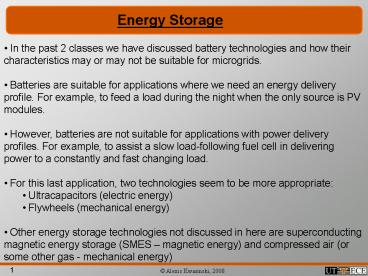Energy Storage PowerPoint PPT Presentation
1 / 22
Title: Energy Storage
1
Energy Storage
- In the past 2 classes we have discussed battery
technologies and how their characteristics may or
may not be suitable for microgrids. - Batteries are suitable for applications where we
need an energy delivery profile. For example, to
feed a load during the night when the only source
is PV modules. - However, batteries are not suitable for
applications with power delivery profiles. For
example, to assist a slow load-following fuel
cell in delivering power to a constantly and fast
changing load. - For this last application, two technologies seem
to be more appropriate - Ultracapacitors (electric energy)
- Flywheels (mechanical energy)
- Other energy storage technologies not discussed
in here are superconducting magnetic energy
storage (SMES magnetic energy) and compressed
air (or some other gas - mechanical energy)
2
Power vs. energy delivery profile technologies
- Ragone chart
- More information and charts can be found in Holm
et. al., A Comparison of Energy Storage
Technologies as Energy Buffer in Renewable Energy
Sources with respect to Power Capability.
3
Power vs. energy delivery profile technologies
4
Electric vs. Magnetic energy storage
- Consider that we compare technologies based on
energy density (J/m3) - Plot of energy density vs. length scale
(distance between plates or air gap) - Hence, magnetic energy storage (e.g. SMES) is
effective for large scale systems (higher power)
University of Illinois at Urbana-Champaign ECE
468 (Spring 2004)
5
Ultracapacitors
- Capacitors store energy in its electric field.
- In ideal capacitors, the magnitude that relates
the charge generating the electric field and the
voltage difference between two opposing metallic
plates with an area A and at a distance d, is the
capacitance - In ideal capacitors
- Equivalent model of real standard capacitors
6
Ultracapacitors
- Ultracapacitors technology construction
- Double-layer technology
- Electrodes Activated carbon (carbon cloth,
carbon black, aerogel carbon, particulate from
SiC, particulate from TiC) - Electrolyte KOH, organic solutions, sulfuric
acid.
http//www.ultracapacitors.org/img2/ultracapacitor
-image.jpg
7
Ultracapacitors
- Ultracapacitors technology construction
- Key principle area is increased and distance is
- decreased
- There are some similarities with batteries but
there are - no reactions here.
Ultracapacitor with carbon nano-tubes electrodes
Double layer capacitor (ultracapacitor)
Traditional standard capacitor
The charge of ultracapacitors, IEEE Spectrum Nov.
2007
8
Ultracapacitors
- Ultracapacitors technology construction
www.ansoft.com/firstpass/pdf/CarbonCarbon_Ultracap
acitor_Equivalent_Circuit_Model.pdf
9
Ultracapacitors
- Some typical Maxwells ultracapacitor packages
- At 2.7 V, a BCAP2000 capacitor can store more
than 7000 J in the volume of a soda can. - In comparison a 1.5 mF, 500 V electrolytic
capacitor can store less than 200 J in the same
volume.
www.ansoft.com/firstpass/pdf/CarbonCarbon_Ultracap
acitor_Equivalent_Circuit_Model.pdf
10
Ultracapacitors
- Comparison with other capacitor technologies
www.ansoft.com/firstpass/pdf/CarbonCarbon_Ultracap
acitor_Equivalent_Circuit_Model.pdf
11
Ultracapacitors
- Charge and discharge
- With constant current, voltage approximate a
linear variation due to a very large time
constant - Temperature affects the output (discharge on a
constant power load)
www.ansoft.com/firstpass/pdf/CarbonCarbon_Ultracap
acitor_Equivalent_Circuit_Model.pdf
12
Ultracapacitors
- Aging process
- Life not limited by cycles but by aging
- Aging influenced by temperature and cell voltage
- Overtime the materials degrade, specially the
electrolyte - Impurities reduce a cells life.
Linzen, et al., Analysis and Evaluation of
Charge-Balancing Circuits on Performance,
Reliability, and Lifetime of Supercapacitor
Systems
13
Ultracapacitors
- Power electronic interface
- It is not required but it is recommended
- It has 2 purposes
- Keep the output voltage constant as the
capacitor discharges (a simple boost converter
can be used) - Equalize cell voltages (circuit examples are
shown next)
14
Ultracapacitors
- Model (sometimes similar to batteries)
Mierlo et al., Journal of Power Sources 128
(2004) 7689
http//www.ansoft.com/leadinginsight/pdf/High20Pe
rformance20Electromechanical20Design/Ultracapaci
tor20Distributed20Model20Equivalent20Circuit2
0For20Power20Electronic20Circuit20Simulation.p
df
Ultracapacitors for Use in Power Quality
and Distributed Resource Applications, P. P.
Barker
15
Flywheels
- Energy is stored mechanically (in a rotating
disc)
Motor
Generator
Flywheels Energy Systems
16
Flywheels
http//www.vyconenergy.com
http//www.pentadyne.com
17
Flywheels
- Kinetic energy
- where I is the moment of inertia and ? is the
angular velocity of a rotating disc. - For a cylinder the moment of inertia is
- So the energy is increased if ? increases or if
I increases. - I can be increased by locating as much mass on
the outside of the disc as possible. - But as the speed increases and more mass is
located outside of the disc, mechanical
limitations are more important.
18
Flywheels
- Disc shape and material the maximum energy
density per mass and the maximum tensile stress
are related by - Typically, tensile stress has 2 components
radial stress and hoop stress.
19
Flywheels
- Since
- (1)
- and
- (2)
- and
- (3)
- then, from (2) and (3)
- (4)
- So, replacing (1) in (4) it yields
20
Flywheels
- However, high speed is not the only mechanical
constraint - If instead of holding output voltage constant,
output power is held constant, then the torque
needs to increase (because P T?) as the speed
decreases. Hence, there is also a minimum speed
at which no more power can be extracted - If
- and if an useful energy (Eu) proportional to the
difference between the disk energy at its maximum
and minimum allowed speed is compared with the
maximum allowed energy (Emax) then
Eu/Emax
Bernard et al., Flywheel Energy Storage Systems
In Hybrid And Distributed Electricity Generation
Vr
Vr
21
Flywheels
- In order to reduce the friction (hence, losses)
the disc is usually in a vacuum chamber and uses
magnetic bearings. - Motor / generators are typically permanent
magnet machines. There are 2 types axial flux
and radial flux. AFPM can usually provide higher
power and are easier to cool.
Bernard et al., Flywheel Energy Storage Systems
In Hybrid And Distributed Electricity Generation
Bernard et al., Flywheel Energy Storage Systems
In Hybrid And Distributed Electricity Generation
22
Flywheels
- Simplified dynamic model
- Typical outputs
Flywheels Energy Systems

